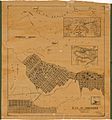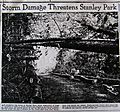Stanley Park facts for kids
Stanley Park is a very large and famous park in Vancouver, British Columbia, Canada. It first opened to the public on September 27, 1888. The park was named after Frederick Stanley, 16th Earl of Derby, who was the Governor General of Canada at that time. A Governor General is like a representative of the King or Queen in Canada.
Stanley Park is one of the biggest parks in North America that is located inside a city. It covers about 404 hectares (which is about 1,000 acres). Every year, around 8 million people visit the park. It is even bigger than New York City's famous Central Park. Inside Stanley Park, you can find a large aquarium, a protected forest, the beautiful Lost Lagoon, tall totem poles, and many other fun things to see and do.
Contents
What to See in Stanley Park
Stanley Park has many interesting places to explore. It's a great spot for families and friends to spend time outdoors.
The Vancouver Aquarium
One of the most popular places in the park is the Vancouver Aquarium. It's home to many different kinds of sea animals. You can see fish, sea otters, dolphins, and more. It's a fun place to learn about ocean life.
Exploring the Forest
A big part of Stanley Park is a thick, green forest. You can walk or bike on many trails through the trees. It's a great way to feel like you're far away from the city, even though you're right in the middle of it!
The Lost Lagoon
The Lost Lagoon is a calm, pretty lake inside the park. It's a peaceful spot where you can often see ducks, geese, and other birds. It's a nice place to relax and enjoy nature.
Totem Poles
At Brockton Point, you can see a collection of tall, colorful totem poles. These poles are carved by First Nations artists and tell stories or represent important events. They are an important part of the history and culture of the local Indigenous peoples.
The Seawall
The Seawall is a famous path that goes all the way around the edge of Stanley Park. It's a perfect place for walking, jogging, or biking while enjoying amazing views of the ocean and the city skyline.
History of Stanley Park
Stanley Park has a long history, even before it became a park.
Early Days
For thousands of years, the land that is now Stanley Park was home to First Nations people. They used the area for hunting, fishing, and gathering food. You can still see some signs of their history in the park today.
Becoming a Park
In the late 1800s, the land was set aside to become a park. It was officially opened in 1888. The park was created to protect the natural beauty of the area and provide a green space for everyone in Vancouver to enjoy.
Changes Over Time
Over the years, Stanley Park has changed. There used to be a small zoo, but it is now closed. The park has also faced challenges like big storms, which have damaged some of its old trees. However, people work hard to keep the park beautiful and safe for visitors.
Related pages
Images for kids
-
View of Siwash Rock taken from the forest trail above
-
A painting of ships used in George Vancouver's exploration of the west coast of North America in his 1791–1795 expedition
-
An 1897 settlement in Stanley Park. The centre house is the traditional longhouse style of the Squamish people.
-
Springboard notched stumps attest to pre-park logging activities.
-
1928 photo of the home of Tim Cummings, the last person to live at Brockton Point
-
Map showing the location of WWII defence forts, including Ferguson Point (Stanley Park)
-
Vancouver Province photo of debris left by 1934–1935 storms and warning of the fire hazard if not cleaned up
-
The National Geographic western red cedar before it was uprooted after being ravaged in 2006 by what is called in the US the Hanukkah Eve windstorm
-
"Royal" lily pads on Beaver Lake
-
Lost Lagoon looking north
-
The Japanese Canadian War Memorial was erected through private donations in memory of Japanese Canadians who served in World War I.
See also
 In Spanish: Parque Stanley para niños
In Spanish: Parque Stanley para niños





















